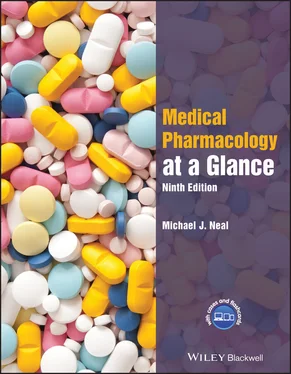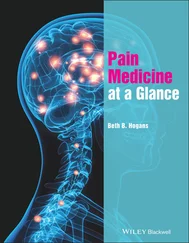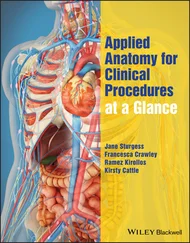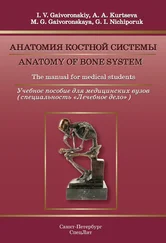The transmitter substance released at sympathetic nerve endings is noradrenaline ( norepinephrine; top left). Inactivation of this transmitter occurs largely by reuptake into the nerve terminals. Some preganglionic sympathetic fibres pass directly to the adrenal medulla (  ), which can release adrenaline ( epinephrine) into the circulation. Norepinephrine and epinephrine produce their actions on effector organs by acting on α‐, β 1‐ or β 2‐ adrenoceptors(extreme left).
), which can release adrenaline ( epinephrine) into the circulation. Norepinephrine and epinephrine produce their actions on effector organs by acting on α‐, β 1‐ or β 2‐ adrenoceptors(extreme left).
In the parasympathetic system, the preganglionic fibres (right, ) leave the central nervous system via the cranial nerves (especially III, VII, IX and X) and the third and fourth sacral spinal roots. They often travel much further than sympathetic fibres before synapsing in ganglia (  ), which are often in the tissue itself (right).
), which are often in the tissue itself (right).
The nerve endings of the postganglionic parasympathetic fibres (right,  ) release acetylcholine(top right), which produces its actions on the effector organs (right) by activating muscarinic receptors. Acetylcholine released at synapses is inactivated by the enzyme acetylcholinesterase.
) release acetylcholine(top right), which produces its actions on the effector organs (right) by activating muscarinic receptors. Acetylcholine released at synapses is inactivated by the enzyme acetylcholinesterase.
All the preganglionic nerve fibres (sympathetic and parasympathetic, ) are myelinated and release acetylcholine from the nerve terminals; the acetylcholine depolarizes the ganglionic neurones by activating nicotinic receptors.
A small proportion of autonomic nerves release neither acetylcholine nor norepinephrine. For example, the cavernous nerves release nitric oxide (NO) in the penis. This relaxes the smooth muscle of the corpora cavernosa (via cyclic guanosine monophosphate [cGMP], Chapter 16) allowing expansion of the lacunar spaces and erection. Sildenafil, used in male sexual dysfunction, inhibits phosphodiesterase type 5 and, by increasing the concentration of cGMP, facilitates erection.
Adrenalinemimics most sympathetic effects, i.e. it is a sympatho‐mimetic agent ( Chapter 9). Elliot suggested in 1904 that adrenaline was the sympathetic transmitter substance, but Dale pointed out in 1910 that noradrenalinemimicked sympathetic nerve stimulation more closely.
Effects of sympathetic stimulation
These are most easily remembered by thinking of changes in the body that are appropriate in the ‘ fight or flight reaction ’. Note which of the following effects are excitatory and which are inhibitory.
1 Pupillary dilatation (more light reaches the retina).
2 Bronchiolar dilatation (facilitates increased ventilation).
3 Heart rate and force are increased; blood pressure rises (more blood for increased activity of skeletal muscles – running!).
4 Vasoconstriction in skin and viscera and vasodilatation in skeletal muscles (appropriate redistribution of blood to muscles).
5 To provide extra energy, glycogenolysis is stimulated and the blood glucose level increases. The gastrointestinal tract and urinary bladder relax.
These are divided into two main types: α‐receptors mediate the excitatory effects of sympathomimetic amines, whereas their inhibitory effects are generally mediated by β‐receptors (exceptions are the smooth muscle of the gut, for which α‐stimulation is inhibitory, and the heart, for which β‐stimulation is excitatory). Responses mediated by α‐ and β‐receptors can be distinguished by: (i) phentolamine and propranolol, which selectively block α‐ and β‐receptors, respectively; and (ii) the relative potencies, on different tissues, of norepinephrine (NE), epinephrine (E) and isoprenaline (I). The order of potency is NE > E > I where excitatory (α) responses are examined, but for inhibitory (β) responses this order is reversed (I >> E > NE).
β‐Adrenoceptorsare not homogeneous. For example, norepinephrine is an effective stimulant of cardiac β‐receptors, but has little or no action on the β‐receptors mediating vasodilatation. On the basis of the type of differential sensitivity they exhibit to drugs, β‐receptors are divided into two types: β 1(heart, intestinal smooth muscle) and β 2(bronchial, vascular and uterine smooth muscle).
α‐Adrenoceptorsare divided into two classes, originally depending on whether their location is postsynaptic (α 1) or presynaptic (α 2). Stimulation of the presynaptic α 2‐receptors by synaptically released norepinephrine reduces further transmitter release (negative feedback). Postsynaptic α 2‐receptors occur in a few tissues, e.g. brain, vascular smooth muscle (but mainly α 1).
Acetylcholine is the transmitter substance released by the following:
1 All preganglionic autonomic nerves (i.e. both sympathetic and parasympathetic).
2 Postganglionic parasympathetic nerves.
3 Some postganglionic sympathetic nerves (i.e. thermoregulatory sweat glands and skeletal muscle vasodilator fibres).
4 Nerve to the adrenal medulla.
5 Somatic motor nerves to skeletal muscle endplates ( Chapter 6).
6 Some neurones in the central nervous system ( Chapter 22).
Acetylcholine receptors (cholinoceptors)
These are divided into nicotinic and muscarinic subtypes (originally determined by measuring the sensitivity of various tissues to the drugs nicotine and muscarine, respectively).
Acetylcholine released at the nerve terminals of postganglionic para‐sympathetic fibres acts on muscarinic receptors and can be blocked selectively by atropine. Five subtypes of muscarinic receptor exist, three of which have been well characterized: M 1, M 2and M 3. M 1‐receptors occur in the brain and gastric parietal cells, M 2‐receptors in the heart and M 3‐receptors in smooth muscle and glands. Except for pirenzepine, which selectively blocks M 1‐receptors ( Chapter 12), clinically useful muscarinic agonists and antagonists show little or no selectivity for the different subtypes of muscarinic receptor.
These occur in autonomic ganglia and in the adrenal medulla, where the effects of acetylcholine (or nicotine) can be blocked selectively with hexamethonium. The nicotinic receptors at the skeletal muscle neuromuscular junction are not blocked by hexamethonium, but are blocked by tubocurarine. Thus, receptors at ganglia and neuromuscular junctions are different, although both types are stimulated by nicotine and therefore called nicotinic.
Muscarinic effectsare mainly parasympathomimetic (except sweating and vasodilatation), and in general are the opposite of those caused by sympathetic stimulation. Muscarinic effects include: constriction of the pupil, accommodation for near vision ( Chapter 10), profuse watery salivation, bronchiolar constriction, bronchosecretion, hypotension (as a result of bradycardia and vasodilatation), an increase in gastro‐intestinal motility and secretion, contraction of the urinary bladder and sweating.
Читать дальше

 ), which can release adrenaline ( epinephrine) into the circulation. Norepinephrine and epinephrine produce their actions on effector organs by acting on α‐, β 1‐ or β 2‐ adrenoceptors(extreme left).
), which can release adrenaline ( epinephrine) into the circulation. Norepinephrine and epinephrine produce their actions on effector organs by acting on α‐, β 1‐ or β 2‐ adrenoceptors(extreme left). ), which are often in the tissue itself (right).
), which are often in the tissue itself (right). ) release acetylcholine(top right), which produces its actions on the effector organs (right) by activating muscarinic receptors. Acetylcholine released at synapses is inactivated by the enzyme acetylcholinesterase.
) release acetylcholine(top right), which produces its actions on the effector organs (right) by activating muscarinic receptors. Acetylcholine released at synapses is inactivated by the enzyme acetylcholinesterase.










